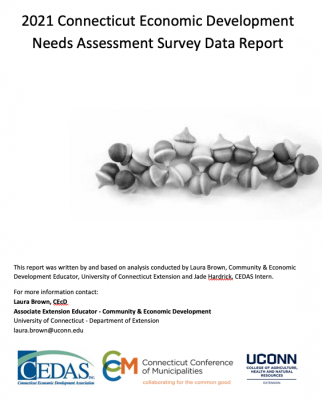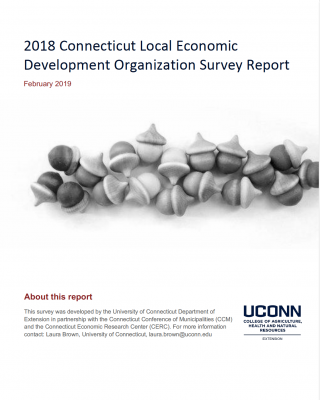 Background
Background
The purpose of the 2021 Economic Development Organization Survey was to understand current areas of focus, challenges, opportunities, as well as educational and professional needs in economic development emerging as a result of the COVID-19 pandemic. This information may be used by municipalities, local elected officials, and resource providers to support economic development programs that are most effective and relevant to communities across the state. The survey was assessed as a Qualtrics online questionnaire in May-June 2021 with a response period of three weeks. A link to access the questionnaire was disseminated through the Connecticut Economic Development Association, Connecticut Conference of Municipalities, the state economic development practitioner’s listserv, as well as the Connecticut Chapter of the American Planning Association and personal distribution lists of coordinating partners. The survey included 18 questions regarding the geographic scope of economic development functions, constituents, primary areas of work, barriers and opportunities for economic development, COVID-19 response, professional and training needs, and demographic information about economic development staff. A copy of the survey tool is available upon request and as an appendix to this report. This project was reviewed by the University of Connecticut IRB and was determined to not qualify as human subjects research under 45CFR46.102. Significant findings are highlighted in bold in the text below. There were 140 respondents to the survey included in the statewide analysis.
Key Findings
-
Economic developers take on a diverse range of roles in communities including business assistance (60%), real estate/infrastructure development (13%), and land use planning (11%).
-
While resource limitations including lack of funding for municipalities or development topped the list of barriers to economic development,(28%), engagement and capacity challenges such as NIMB-ISM (Not In My Backyard), lack of care/interest, and lack of regional collaboration/coordination pose a significant barrier to economic development (20%).
-
Respondents overwhelmingly identified housing/development improvements (45%) as the most significant emerging opportunity, encompassing nearly half of all responses.
-
When asked what might have helped them respond more effectively to the COVID-19 pandemic funding for organizations and businesses topped the list. However, many identified some resilience factors that might have allowed them to be more prepared, particularly related to communication with businesses and residents.
